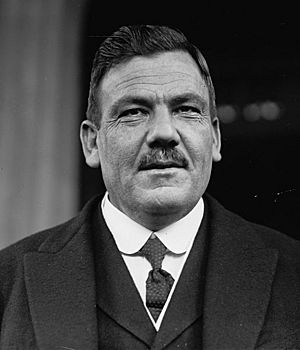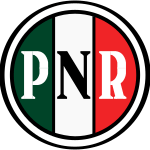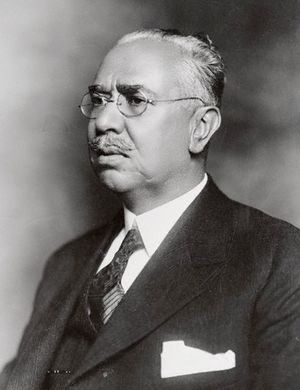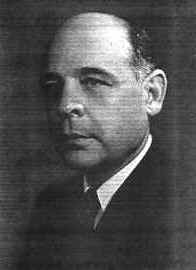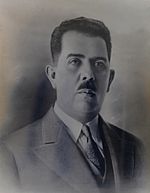Maximato facts for kids
The Maximato was a special time in Mexico's history, lasting from 1928 to 1934. It's named after a former president, Plutarco Elías Calles, who was called el Jefe Máximo, meaning "the maximum leader." During the Maximato, Calles was not the president, but he still had a lot of power and influence. This six-year period was supposed to be for President-elect Álvaro Obregón, but he was sadly assassinated right after the 1928 elections.
Mexico needed a quick solution for who would lead the country. Calles could not be president again because of rules about re-election. However, he was still the most important person in Mexican politics. There were two main ways they solved this problem. First, an interim (temporary) president was chosen, and then new elections were held. Second, Calles created a very important political group called the Partido Nacional Revolucionario (PNR). This party held presidential power in Mexico for many years, from 1929 to 2000.
Emilio Portes Gil served as the temporary president from December 1, 1928, to February 4, 1930. He was not chosen as the PNR's candidate for the next election. Instead, a less known politician, Pascual Ortiz Rubio, became president. Ortiz Rubio resigned in September 1932 because Calles still held the real power. Abelardo L. Rodríguez then became president and finished the term, which ended in 1934. Rodríguez showed more independence from Calles than Ortiz Rubio had. In 1934, Lázaro Cárdenas, a former revolutionary general, won the election as the PNR's candidate. After Cárdenas became president, Calles tried to control him. But Cárdenas was smart and, with the help of his allies, he politically outsmarted Calles. In 1936, Cárdenas sent Calles and his main supporters out of the country.
The Maximato was a time when ex-President Calles had a lot of personal power. But it was also important because it helped create a strong political party system in Mexico. This was a big step in Mexican history.
Contents
Why the Maximato Happened
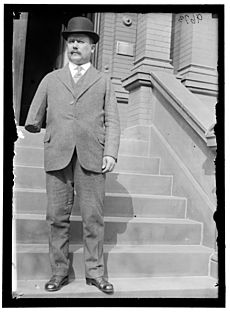
A key idea from the Mexican Revolution was "no re-election." This was because Porfirio Díaz had been president for a very long time (1876-1911). In the 1920s, three generals from the state of Sonora – Adolfo de la Huerta, Álvaro Obregón, and Plutarco Elías Calles – were very powerful in Mexico.
President Venustiano Carranza tried to choose his own successor in 1920. But the three Sonoran generals rebelled against him. De la Huerta was a temporary president for six months. Then, Obregón won the 1920 election and served as president from 1920 to 1924. In the 1924 elections, Obregón supported Calles over De la Huerta. De la Huerta led a failed revolt and then left the country. Calles won the presidency and served from 1924 to 1928.
Obregón remained very influential even when Calles was president. Calles even changed the constitution to allow a president to be re-elected after a break. This meant Obregón could run again in 1928. Obregón was elected as Calles's successor. However, he was assassinated in July 1928 by José de León Toral, a Catholic activist, before he could take office. People were very surprised and confused by the assassination. Calles allowed Obregón's supporters to be angry. He directed their anger towards others, like the labor leader Luis N. Morones, who some thought might be responsible.
How the PNR Party Was Created
Calles could not be president again, but he wanted to keep his power. So, he found a political solution. This solution was very important for Mexican politics. In his report to congress on September 1, 1928, after Obregón's assassination, Calles said that no single person was strong enough to lead the country alone. He called for Mexico to become a country where institutions and laws were more important than individual leaders.
Calles had already asked thirty important generals to agree to a civilian (non-military) temporary president. This was until new elections could happen. Emilio Portes Gil became the temporary president. He took office on December 1, 1928, and served until February 5, 1930. Calles still held power, even though he had said he would never be president again. This statement also meant that no future president could seek re-election right away.
Not all generals agreed with this new political plan. General José Gonzalo Escobar led a rebellion in March 1929 against the Portes Gil government. The United States supported the temporary government. Escobar could not get enough weapons, so his revolt failed. This short rebellion showed how important it was to find a better way to choose presidents. It also helped end the Cristero War. Calles himself led the government troops to stop the Escobar Rebellion.
Calles was key in starting the Partido Nacional Revolucionario (PNR). This party was the first version of today's Partido Revolucionario Institucional (PRI). It was a way for Calles's group to control who became president. The party became strong by including many different groups. These included local political groups, organized workers, farmers, and professionals like government workers and teachers. The party got money and became organized by requiring members of these groups to pay dues. It became a national party that existed all the time, not just during elections. It was very successful in elections at all levels of government.
After 1929, Calles officially served as the minister of war. He continued to deal with the Cristero War rebellion. However, a few months later, with help from the United States ambassador Dwight Morrow, the Mexican government and the Cristeros signed a peace agreement.
Pascual Ortiz Rubio's Presidency
The PNR chose Pascual Ortiz Rubio as its candidate for the 1929 election. Ortiz Rubio was not well-known and did not have his own strong group of supporters. During the two years Ortiz Rubio was officially president of Mexico, Calles was the real power behind the presidency.
Ortiz Rubio won the 1929 election, which was very controversial. He defeated the philosopher José Vasconcelos and Pedro Rodríguez Triana of the Mexican Communist Party. The election had violence and cheating. Vasconcelos refused to accept the results. Many of his supporters were killed, and Vasconcelos left the country.
Ortiz Rubio became president on February 5, 1930. But there was still a lot of anger. During his inauguration ceremony, Ortiz Rubio was shot by a student who opposed the election results. The student was later sentenced to death.
During the Maximato, Calles became more controlling. After a big protest in 1930, the Mexican Communist Party was banned. Mexico stopped supporting rebels in Nicaragua. Strikes by workers were no longer allowed. The government also stopped giving land to poorer farmers. Calles had once supported workers, but later, as he became wealthy, he stopped Communism. Overall, the Maximato saw more extreme political groups, both left and right, often fighting in Mexico's cities. In 1932, Calles forced Ortiz Rubio to resign. This happened because Ortiz Rubio had appointed some people who did not support Calles to government jobs.
Abelardo L. Rodríguez's Presidency (1932-1934)
Ortiz Rubio was replaced by General Abelardo L. Rodríguez. Rodríguez was a friend and supporter of Calles. Since Ortiz Rubio had served long enough as president, a new election was not needed. So, Congress appointed Rodríguez as the substitute president. Calles was still important during Rodríguez's time in office. However, Calles was less involved in politics because he was ill. His young second wife also became ill and passed away in 1932. Rodríguez set clear limits on Calles's actions. He made it clear that he, Rodríguez, was the president of Mexico and deserved all the respect and power of the office.
Rodríguez was known for making good changes. During his presidency, social laws promised by the Mexican constitution of 1917 were finally put into action. These included a minimum wage and an 8-hour workday. During Rodríguez's time, the constitutional change that allowed re-election was removed. The presidential term was also extended to six years.
Rodríguez's secretary of education, Narciso Bassols, tried to create a system of "socialist education." The constitution was changed for this purpose. However, parts of these changes that tried to suppress religion were removed from the constitution in 1946.
The End of the Maximato
In 1934, the PNR chose revolutionary general Lázaro Cárdenas as its presidential candidate. He was from Michoacán. Soon after Cárdenas became president, problems started between him and Calles. Calles did not like Cárdenas's support for labor unions, especially his acceptance of strikes. Cárdenas did not like Calles's harsh methods and his closeness to groups like the Gold Shirts. This group, led by General Nicolás Rodríguez Carrasco, bothered communists, Jewish people, and Chinese people.
Cárdenas began to weaken Calles's power. He removed Calles's supporters from political jobs. He also sent Calles's most powerful allies out of the country. These included Tomás Garrido Canabal, Fausto Topete, Emilio Portes Gil, Saturnino Cedillo, and Aarón Sáenz. Finally, Calles himself was arrested. Calles and Luis Napoleon Morones, one of Calles's last powerful supporters, were accused of planning to blow up a railroad. They were arrested by order of President Cárdenas. On April 9, 1936, they were sent to the United States. It was reported that when Calles was arrested, he was reading a Spanish translation of Mein Kampf.
See also
 In Spanish: Maximato para niños
In Spanish: Maximato para niños


